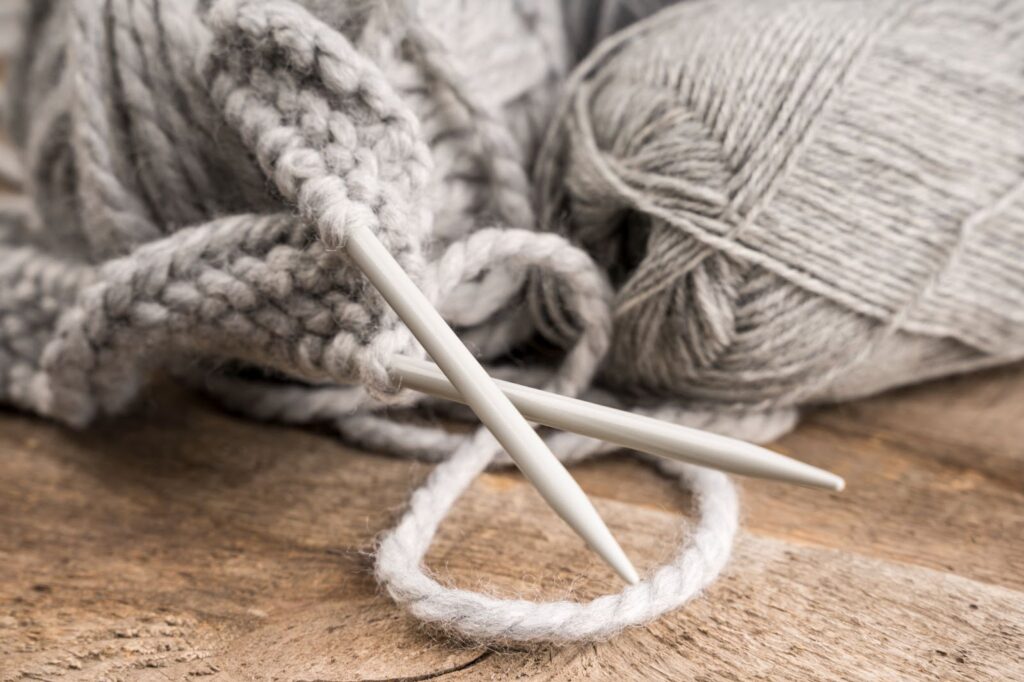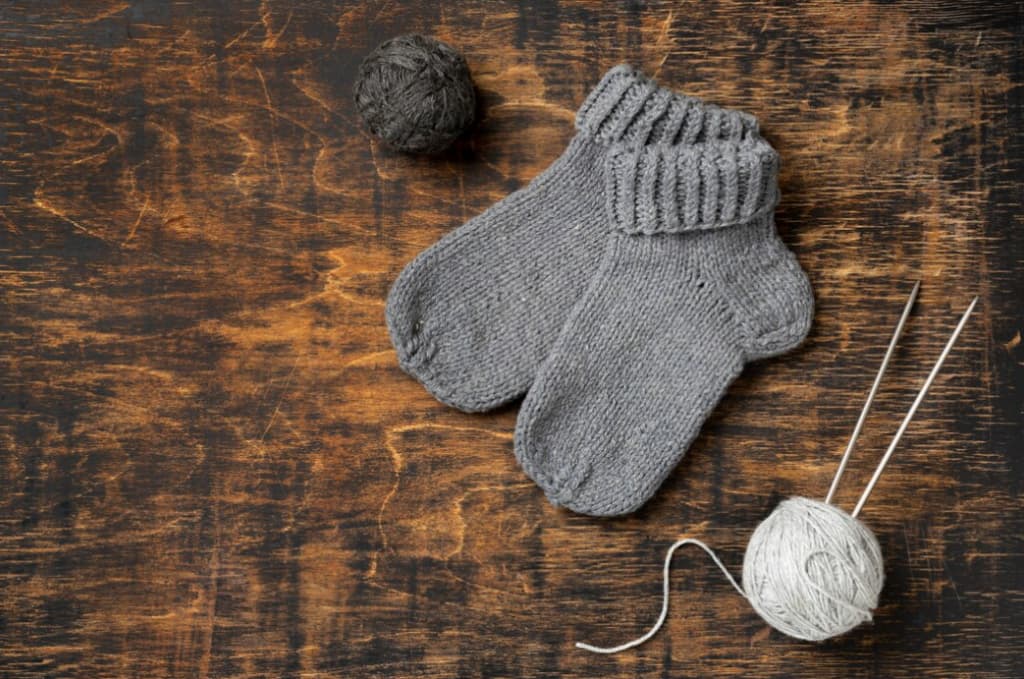Greetings! This week, I’m excited to present a brief tutorial on the technique of executing the German Twisted Cast-On. This particular cast-on, often referred to as the Old Norwegian Cast On, is especially favored when embarking on projects like my Giant Color Shift Brioche Scarf. It possesses the remarkable ability to provide your knitting with an exceptionally pliable and stretchy commencement, making it an ideal choice for Brioche or any endeavor that demands a flexible and elastic start!
Embarking on this knitting journey requires assembling some essential items. Here’s a list of what you’ll need:
- Selecting the Right Yarn: Choose yarn that resonates with your project’s theme and functionality. Consider the texture, color, and thickness that best suit your design;
- Matching Knitting Needles: The needle size should correspond with the yarn thickness for optimal results. Utilizing the correct needle size is crucial for maintaining consistent tension throughout your project;
- Scissors: A pair of sharp scissors will be necessary for cutting yarn with precision;
- Knitting Instructions: Begin by having your selected knitting pattern readily available. It will function as your informative companion, elucidating the precise prerequisites and measurements for your undertaking.
With these materials in your possession, you are fully prepared to embark on the exploration of the German Twisted Cast On technique. The subsequent steps will escort you through this approach, guaranteeing that your knitting’s edge is not only elastic but also imparts a sophisticated flourish to your craftsmanship. The handbook will encompass suggestions for upholding consistent tension, addressing typical challenges, and proposing scenarios where this casting-on technique can be particularly advantageous. Whether you find yourself in the early stages of knitting or possess a wealth of experience, this instructional guide aims to elevate your competencies and diversify your knitting repertoire.
The Art of the German Twisted Cast On: Crafting Elastic and Reliable Edges for Your Knitting Projects
Are you a knitting enthusiast searching for a technique that combines durability and elasticity in your projects? Look no further than the German Twisted Cast On. This method is a true gem, particularly well-suited for socks, hats, cuffs, and any other knitting endeavor that demands a sturdy yet flexible edge. In this comprehensive guide, we’ll take you through the steps to master this technique and provide valuable tips for success.
Initial Setup:
Establishing the Base: The German Twisted Cast On Technique
Embarking on the knitting journey entails laying the foundation with the German Twisted Cast On method. Commence by skillfully fashioning a slip knot, ensuring its secure placement on the knitting needle. Orient the yarn tail towards yourself, establishing this as the pivotal inaugural step in your casting-on process.
Preparing the Yarn:
Yarn management constitutes a pivotal element in the art of knitting. Grasp the yarn firmly with your left hand, mirroring the setup of the Long-Tail Cast On. To ensure effective yarn control, adhere to the following steps:
- Loop the yarn tail around your thumb, thus forming a snug loop;
- Allow the yarn extending from the ball to encircle your index finger;
- With your right hand, firmly grasp the knitting needle already accommodating the slip knot.
Precision in Needle Placement
Delve deeper into this unique technique. Contrary to the Long-Tail method, carefully slide the needle beneath both yarn strands adjacent to your thumb, bypassing just the loop.
Mastering Loop Navigation
Maneuver the needle tip in a precise path: descend through the thumb loop, then ascend on the side closest to you, ensuring the needle remains external to the loop.
Strategic Yarn Wrapping
Transition the needle from right to left beneath the index finger’s yarn strand. Aim to position the needle strategically between the yarn loops on your thumb and forefinger.
The Art of Stitch Formation
Here lies the essence of the technique. Gently draw the needle towards you, passing it under and then lifting it through the gap between the two yarn strands on your thumb.
Securing the Stitch
With a gentle motion, release the yarn from your thumb. Simultaneously, tighten the newly crafted stitch on the needle. It’s crucial to strike a balance in tension — firm enough to hold its shape, yet loose enough for future knitting into this stitch.
Repeating and Advancing:
Having mastered these foundational steps, proceed to cast on the required number of stitches. Continuously repeat Steps 3 to 7 to meet your project’s specific stitch count. Once the cast on is complete, you’re set to embark on the knitting pattern as per your project’s guidelines. This repetitive process not only solidifies your skill in this technique but also sets the stage for a beautifully crafted knitting project.
Tips for Success:
To truly excel at the German Twisted Cast On and ensure your knitting projects start on the right foot, consider these tips:
- Ensure even tension for a uniform edge;
- Practice the technique to gain speed and consistency;
- If the edge feels too tight, don’t hesitate to use a larger needle size.
Try It Out!
The best way to solidify your understanding of the German Twisted Cast On is to put it into practice immediately. To get started, here are some project ideas that will showcase the beauty of this technique:
Project Ideas:
- Cozy Scarf: Craft a warm and stylish scarf with a German Twisted Cast On for a luxurious edge;
- Elegant Cardigan: Elevate your cardigan game with a professional cast-on edge that sets your project apart;
- Baby Blanket: Create a soft and heirloom-quality baby blanket using this method for an extra touch of care and craftsmanship;
- Textured Mittens: Add depth and dimension to your mittens by incorporating the German Twisted Cast On. The twisted edge complements textured stitches beautifully.
Advantages of Employing the German Twisted Cast-On Method
The German Twisted Cast-On technique is celebrated for its versatility and functionality in knitting projects. Below are its key benefits, each elaborated for a deeper understanding:
Enhanced Elasticity:
- Ideal for Fitted Knitting Pieces: This method creates a stretchable edge, perfect for items like sock cuffs, sweater collars, and hat brims that require a snug fit;
- Comfort & Fit: The elasticity ensures a comfortable wear, adapting to various shapes without constricting movement.
Enhancing Visual Allure:
The intricacies of the stitches impart a distinctive and ornamental texture, elevating the visual charm of your knitted creations.
Versatility in Style:
This technique seamlessly complements both contemporary and traditional knitting patterns, infusing an element of elegance.
A Crisp and Neat Commencement:
Achieving a polished and tidy project outset, the German Twisted Cast-On method bestows a professional touch, imparting a refined and finished look to your knitting endeavors.
Guarding Against Unraveling:
By securely anchoring the yarn, this method adeptly mitigates the risk of fraying or unwinding from the very beginning.
Adaptable for Various Projects:
Boasting a broad spectrum of applications, this approach finds suitability in a myriad of knitting undertakings, spanning from clothing to accessories.
Compatibility with Diverse Yarns:
The technique harmonizes effortlessly with a plethora of yarn types, fostering creative adaptability.
Guidance for Knitting Enthusiasts:
- Mastery through Repetition: For those unacquainted with this technique, honing your skills on spare yarn is advisable to attain proficiency in both tension and execution;
- Thoughtful Yarn Selection: Opt for yarns that complement the inherent elasticity and texture of this cast-on, ensuring optimal results;
- Fusion with Alternate Techniques: Unleash your creativity by experimenting with the fusion of this cast-on method alongside various knitting patterns, uncovering a world of distinctive design possibilities.
Understanding the German Twisted Cast On: Tips for Perfection
- Understanding the Essence of the Slip Knot: At the heart of knitting lies the pivotal moment of creating the initial loop, which sets the tone for your entire project. Striking the perfect balance in its tightness is paramount;
- Achieving the Ideal Knot Tension: Your goal is to create a loop that snugly embraces the needle while allowing for smooth movement. This delicate equilibrium is the antidote to uneven knitting and guarantees a comfortable start to your creative endeavor.
Maintaining Uniform Yarn Tension for Consistency:
Consistency is Key: When it comes to wrapping yarn and forming those crucial twisted loops, uniform tension is your steadfast ally. Any deviation from this path can result in irregular stitches and can ultimately affect the overall look and texture of your knitted masterpiece.

Crafting Techniques for Perfection:
- Embrace a Rhythmic Approach: Develop a steady and rhythmic hand movement, ensuring that your yarn wrapping remains consistent;
- Pause for Precision: Take frequent breaks to assess the uniformity of your stitches, making necessary adjustments to your grip to uphold a consistent tension.
The Foundation of Flawlessness: Accurate Stitch Counting
Counting with Precision: Casting on with the exact number of stitches required for your project is non-negotiable. An incorrect stitch count can lead to unwanted size variations and pattern misalignments, which can be quite frustrating.
Strategies for Accurate Counting:
- Vocalize Your Progress: As each stitch is crafted, count it aloud to maintain an accurate tally;
- Stitch Marker Mastery: Strategically place stitch markers after completing set numbers of stitches to segment your work, simplifying the counting process;
- Double-Check Diligence: Before advancing beyond the cast-on row, it’s imperative to double-check your stitch count for absolute accuracy.
By keeping these principles at the forefront of their knitting journey, enthusiasts can substantially enhance their proficiency in the German Twisted Cast On technique. Remember, the road to mastery is paved with practice and patience, essential companions in the world of knitting craftsmanship.
Conclusion
In the world of knitting, the German Twisted Cast On technique stands as a reliable choice. Once you’ve mastered it, you’ll have a powerful tool at your disposal to create robust, yet flexible edges for a wide range of projects. The unparalleled elasticity it provides makes it a favorite among knitters worldwide. So, why wait? Dive into this technique and elevate your knitting skills to new heights!






